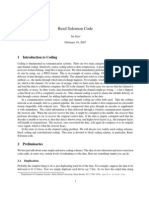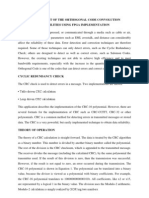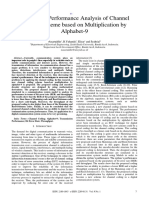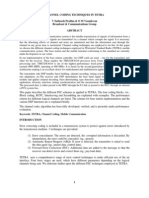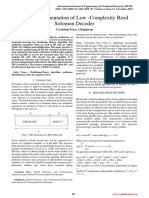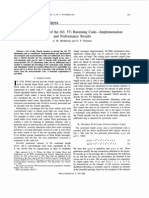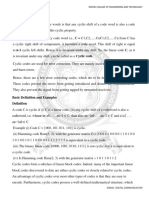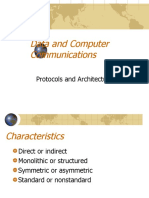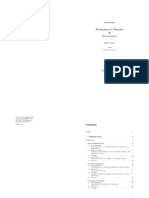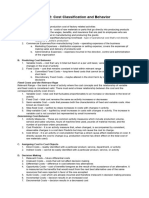Performance Analysis of Reed-Solomon Codes Concatinated With Convolutional Codes Over Awgn Channel
Performance Analysis of Reed-Solomon Codes Concatinated With Convolutional Codes Over Awgn Channel
Uploaded by
kattaswamyCopyright:
Available Formats
Performance Analysis of Reed-Solomon Codes Concatinated With Convolutional Codes Over Awgn Channel
Performance Analysis of Reed-Solomon Codes Concatinated With Convolutional Codes Over Awgn Channel
Uploaded by
kattaswamyOriginal Description:
Original Title
Copyright
Available Formats
Share this document
Did you find this document useful?
Is this content inappropriate?
Copyright:
Available Formats
Performance Analysis of Reed-Solomon Codes Concatinated With Convolutional Codes Over Awgn Channel
Performance Analysis of Reed-Solomon Codes Concatinated With Convolutional Codes Over Awgn Channel
Uploaded by
kattaswamyCopyright:
Available Formats
PERFORMANCE ANALYSIS OF REED-SOLOMON CODES CONCATINATED WITH
CONVOLUTIONAL CODES OVER AWGN CHANNEL
KattaswamyMergu
Lecturer,DepartmentofElectricalandComputerEngineering,WSU,Ethiopia
Email:kattaswamy@gmail.com
Abstract:- With rapid growth in todays technology, digital communication is playing a major role to provide
hostile environment to meet various applications. In this communication, Coding plays a prominent role to
contribute error free transmission through channel coding which improves capacity of a channel by adding some
redundant bit to the original information. One way to provide a better performance of the communication system
is by concatenating different types of channel coding techniques. The concatenation can be done either in
parallel or serial. The primary aim of this paper is to concatenate the Reed-Solomon codes with Convolutional
codes in series, which provides better results comparing with single coding techniques. The performance of the
concatenation of Reed-Solomon codes with Convolutional codes can be evaluated by finding bit error rate with
various values of signal-to-noise ratio over AWGN channel. The analytical result has been obtained by using
MATLAB/OCTAVE.
Keywords: Communication System, Convolutional codes, Reed-Solomon codes, Concatenation, signalto-noise ratio and bit error rate.
1.
INTRODUCTION
The function of the communication system is to
transfer information from one source (or point) to
another source called destination, through a
communication channel. The purpose of the
transmitter is to transform the message signal
produced by the source of information into a form
suitable for transmission over the channel. The
receiver has the task of operating on the received
signal so as to reconstruct a recognizable form of the
original message signal and to deliver it to the user
destination. Channels of the communication are
inevitably noisy and occasionally flip bits that they
are transmitting. Here the sender encoders the data
being sent by adding redundant bits, and receiver
decodes the received string attempting to discover the
location of the errors and correcting the errors. The
field of channel coding is concerned with sending a
stream of data at the highest possible rate over a given
communication channel and then decoding the
original data reliably at the receiver using encoding
and decoding algorithms. In coding theory,
concatenation codes form a class of error correcting
codes used to achieve a low bit error rate.
2.
REED-SOLOMON CODES
ReedSolomon codes were developed in 1960 by
Irving S. Reed and Gustavo Solomon, who were then
staff members of MITL Lincoln Laboratory. This was
entitled "Polynomial Codes over Certain Finite
Fields" as it is based on finite field theory.
Reed-Solomon codes are examples of error
correcting codes, in which redundant information is
added to data so that it can be recovered reliably
despite errors in transmission or storage and retrieval.
Reed Solomon (R-S) codes form an important subclass of the family of Bose- Chaudhuri-Hocquenghem
(BCH) codes. These are very powerful linear nonbinary block codes capable of correcting multiple
random as well as burst errors.
2.1 REED-SOLOMON ENCODING
A Reed-Solomon code is specified as RS (n,k) with sbit symbols. This means that the encoder takes k data
symbols of s bits each and adds parity symbols to
make an n symbol codeword. There are n-k parity
symbols of s bits each. The Reed-Solomon decoder
processes each block and attempts to correct errors
and recover the original data and can correct up to t
symbols that contain errors in a codeword, where 2t =
n-k.
The following diagram shows a typical ReedSolomon codeword
which are necessary to reconstruct the original
encoded block are available to the decoder. If errors
are detected, the decoder attempts a reconstruction.
This is called error correction.
2.2.1 ALGORITHM FOR REED-SOLOMON
DECODING
Figure 1: Systematic format of Reed-Solomon
codeword
2.1.1 ALGORITHM FOR REED SOLOMON
ENCODING
Define the function f(X) or polynomial order
m.
Check whether the function is a primitive
polynomial.
If it is a primitive polynomial then calculate
Galois field 2 m addition & multiplication
for (n,k) block code where
m
n 2 1
m
k 2 1 2t
t = error correcting capability
Generate the generator polynomial G(X)
depending upon the no. of roots
i.e. G X g 0 g1 X g 2 X 2 ... X 2t
To generate parity check matrix P(X),
multiply the message polynomial m(X) with
n-k and divide by generator polynomial
G(X).
Then the encoded codeword U(X) is
generated by combing m X . X nk with
P(X).
i.e. U X m X . X nk P X
2.2 REED-SOLOMON DECODING
Reed-Solomon error correcting codes are frequently
used in communication systems and data storage, to
get back data from possible errors that take place
throughout transmission. One unique application of
the Reed-Solomon codes is the forward error
correction (FEC) i.e., the encoder attaches parity
symbols to the data using a predetermined algorithm
before transmission. When a received block is input to
the decoder for processing, the decoder first verifies
whether this block appears in the dictionary of valid
code words. If it does not, errors must have occurred
during transmission. This part of the decoder
processing is called error detection. The parameters
The received code word r(X) is the original
code word U(X) plus error code word e(X)
i.e., r(X) = U(X)+e(X)
The received code word has 2t syndromes that
depends only on errors and can be calculated by
substituting 2t roots of g(X) into r(X).
Error locator polynomial is obtained by using
Berlekamp-Massey algorithm containing t
unknowns.
Obtain the roots of the polynomial by using
chien search algorithm i.e., to locate the error
positions or locations.
The magnitudes of the error locations are
obtained by using Forney algorithm.
Thus Corrected codeword is obtained as c(X).
3. INTERLEAVER AND DEINTERLEAVER
The performance of Forward Error Correction (FEC)
systems operating in the presence of burst errors is
improved by passing the coded signal through an
interleaver. The interleaving process is added between
two codes to spread burst errors across a wider range.
Interleaving is a technique commonly used in
communication systems to overcome correlated
channel noise such as burst error or fading. The
interleaver rearranges input data such that consecutive
data are spaced apart. Interleaving is a process or
methodology to make a system more efficient, fast
and reliable by arranging data in a noncontiguous
manner. At the receiver end, the interleaved data is
arranged back into the original sequence by
the deinterleaver. As a result of interleaving,
correlated noise introduced in the transmission
channel appears to be statistically independent at the
receiver and thus allows better error correction.
Figure 3: Convolutional Encoding
Figure 2: Example for interleaving technique
4.1.1 ALGORITHM FOR CONVOLUTIONAL
4. CONVOLUTIONAL CODES
ENCODING
Convolutional codes were rst mentioned by Elias in
1955. The name comes from the fact that the
operation involved while encoding is convolution, or
equivalent polynomial multiplication.
Convolutional code works on a continuous data
stream, and its encoding and decoding operations
depend not only on the current data but also on the
previous data. In Convolutional codes the encoded
code words contains memory of previous message
symbols and has to be implemented using sequential
logic. This constitutes the major difference from the
block code, in which the current codeword depends
on the current message block only.
v1 ( X ), v 2 ( X ),...........v n ( X )
4.1 CONVOLUTIONAL ENCODING
Convolutional codes accept a continuous stream of
bits and map them into an output stream introducing
redundancies in the process. The efficiency or data
rate of a Convolutional code is measured by the ratio
of the number of bits in the input k to the number of
bits in the output n.
In a Convolutional code, there is some memory that
remembers the stream of bits flow by which is used to
encode the following bits. Code rate r is determined
by input rate and output rate
rinput
routput
Convolutional codes are generated using
generator polynomials which are multiplied
with input sequence and then XORed.
Let
the
inputs
be
u1 ( X ), u 2 ( X ),.............u n ( X ) .
Let
the
outputs
be
Where v is called a code word.
When message sequence enter the shift
register bit by bit, it gets multiplied with
generated polynomial and is XORed using
Modulo-2 adders to obtain the expressions
v1 ( X ) g1 ( X ) d1 g 2 ( X ) d 2 g 3 ( X ) d 3
v 2 ( X ) g1 ( X ) d1 g 3 ( X ) d 3
Where, d 1 , d 2 , d 3 are shown in Figure 3.
Above procedure is repeated for n number
of input sequence bits.
4.2 CONVOLUTIONAL DECODING
Errors occur during transmission or storage for a
number of reasons like noise, interference, etc.
Convolutional decoder processes sequence of encoded
bits and corrects errors and recover the original data.
One of the decoding algorithms is Viterbi algorithm
which is published by Viterbi in 1967. The algorithm
is optimal in the maximum-likelihood sense, and has
quickly become the most widely used Convolutional
decoding algorithm in practice for its reduced
computational
complexity
and
satisfactory
performance. The Viterbi algorithm is a maximum
likelihood decoder, meaning that the output code
word from decoding a transmission is always the one
with the highest probability of being the correct word
transmitted from the source.
4.2.2
ALGORITHM
FOR
CONVOLUTIONAL
DECODING
Let the binary data is given as input to the
convolutional decoder.
Select an input pair and calculate the branch
metric value i.e., the hamming distance between
the
input
pair
and
ideal
pairs
(00,01,10,11).
Then choose the path for which path metric
value is minimum and thus obtain the decoded
codeword.
5. CONCATENATION OF REED-SOLOMON
CODES WITH CONVOLUTIONAL CODES
Forney (1966) showed that concatenated codes could
be used to achieve exponentially decreasing error
probabilities at all data rates less than capacity. This
also includes the decoding complexity that increases
only polynomially with the code block length N.
The basic concatenated coding scheme is shown in
Figure 4. Forney proposed to construct a channel
coding system by concatenating two codes, an outer
code and an inner code. Both encoders are separated
by an interleaver, whereas the related decoders are
separated by a dual block to the interleaver, i.e. by a
deinterleaver.
Figure 4: Block diagram of Concatenation technique
In the figure, Input message blocks as vectors a are
1
coded in the outer encoder of the code rate R = K/N.
Code words c1 are obtained. Subsequently, bits of
code words c1 are interleaved. As a result, the
received output block consists of the input bits whose
time sequence is changed with respect to the input.
The resulting binary block constitutes the input
sequence of the inner code encoder with the code rate
equal to r = k/n. As we can see, the code rate of the
code concatenation is in fact
Kk
.
Nn
The receiver performs the operations that are dual to
those made in the transmitter. Additive white
Gaussian noise (AWGN) is common to every
communication channel which is the statistically
random radio noise characterized by a wide frequency
range with regards to a signal in the communication
channel. AWGN is a channel model in which the only
impairment to communication is a linear addition of
wideband or white noise with a constant spectral
density (expressed
as watts per hertz of bandwidth)
and a Gaussian distribution of amplitude. Thus, the
decoder of the inner code decides upon the input
message sequence on the basis of the sequence
corrupted by the channel and noise. The resulting
sequence is a subject of de-interleaving in which the
original time sequence of message bits is recovered.
Finally, the outer decoder decodes the de- interleaved
sequence.
6. RESULTS
Concatenation is a method of combining two codes
such as Reed-Solomon codes and convolutional codes
in order to achieve high bit error rate, to minimize the
burst errors.
First we performed the simulations for RS-CC codes
for different block lengths. We can see from fig. 5, as
the block length increases the BER performance
improves. Form the fig.5 we can also see that the RSCC (255,165) gives best results with m=8; i.e. number
of bits per symbol is 8.
Secondly we performed the simulations BER vs SNR
for concatenated codes and single codes. Figure 6
shows the simulation results. From fig. 6 it can be
seen that as SNR increases, bit error rate decreases.
Figure 5: The BER performance of different RS-CC
codes
REFERENCES
[1]
[2]
Figure 6: The BER performance of RS-CC codes with
single codes.
[3]
7. CONCLUSION AND FUTURE SCOPE
[4]
This paper gives deep and clear understanding of
Reed-Solomon codes and Convolutional codes
making them simpler and easier to understand and
implement. From fig.6 we can conclude that bit error
performance of rs-cc codes is good comparing with
the single codes. In this paper we discussed the serial
concatenation of error correcting codes. We can also
perform parallel concatenation of two or more error
correcting codes. We will observe the error
performance of both the concatenated codes.
[5]
[6]
[7]
[8]
B.
Sklar,
Digital
Communications
Fundamentals and Applications, Englewood
Cliffs, New Jersey:
Clark, G. C., Jr., and Cain, J. B., ErrorCorrection
Coding
for
Digital
Communication, Plenum Press, New York,
1981.
Sudan, M., Decoding of Reed-Solomon
Codes Beyond the Error Correction Bound,
J. Complexity, Vol. 12, 1997, pp. 180193.
Wicker, S. B., and V. K. Bhargava, (eds.),
Reed-Solomon
Codes
and
Their
Applications, New York: Wiley-IEEE Press,
1999.
Forney, G. D., Jr., Convolutional Code II:
Maximum Likelihood Decoding, Inform.
Control, Vol. 25, July 1974, pp. 222266.
Viterbi, A. J., Convolutional Codes and
Their Performance in Communication
Systems, IEEE Trans. Inform. Theory, Vol.
IT-17, October 1971, pp. 751772.
Ramsey, J.L.,Realization of Optimum
Interleavers, IEEE Trans. Inform. Theory,
vol. IT-16, no. 3, May 1970, pp 338-345.
Forney, G. D., Jr., Concatenated Codes,
Cambridge, Massachusetts: M. I. T. Press,
1966.
You might also like
- Martin Becker (Auth.) - Heat Transfer - A Modern Approach-Springer US (1986)No ratings yetMartin Becker (Auth.) - Heat Transfer - A Modern Approach-Springer US (1986)432 pages
- Information Theory, Coding and Cryptography Unit-3 by Arun Pratap Singh50% (4)Information Theory, Coding and Cryptography Unit-3 by Arun Pratap Singh64 pages
- Implementation of Berlekamp Algorithm For Error Detection and Correction of Multiple Random Errors Using Reed-Solomon CodesNo ratings yetImplementation of Berlekamp Algorithm For Error Detection and Correction of Multiple Random Errors Using Reed-Solomon Codes4 pages
- Reed Solomon Code: 1 Introduction To CodingNo ratings yetReed Solomon Code: 1 Introduction To Coding4 pages
- Random Neural Network Decoder For Error Correcting CodesNo ratings yetRandom Neural Network Decoder For Error Correcting Codes5 pages
- Tornado Codes and Luby Transform Codes PDFNo ratings yetTornado Codes and Luby Transform Codes PDF12 pages
- Improvement of The Orthogonal Code Convolution Capabilities Using Fpga Implementation100% (2)Improvement of The Orthogonal Code Convolution Capabilities Using Fpga Implementation50 pages
- Design and Performance Analysis of Channel Coding Scheme Based On Multiplication by Alphabet-9No ratings yetDesign and Performance Analysis of Channel Coding Scheme Based On Multiplication by Alphabet-97 pages
- Ijert Ijert: FPGA Implementation of Orthogonal Code Convolution For Efficient Digital CommunicationNo ratings yetIjert Ijert: FPGA Implementation of Orthogonal Code Convolution For Efficient Digital Communication7 pages
- Concatenation and Implementation of Reed - Solomon and Convolutional CodesNo ratings yetConcatenation and Implementation of Reed - Solomon and Convolutional Codes6 pages
- A Novel Approach For FEC Decoding Based On The BP Algorithm in LTE and Wimax SystemsNo ratings yetA Novel Approach For FEC Decoding Based On The BP Algorithm in LTE and Wimax Systems8 pages
- Information Theory and Coding Case Study: Topic: Use of Forward Error Correction Code For White Gaussian Noise ChannelsNo ratings yetInformation Theory and Coding Case Study: Topic: Use of Forward Error Correction Code For White Gaussian Noise Channels3 pages
- Design of Convolutional Encoder and Viterbi Decoder Using MATLABNo ratings yetDesign of Convolutional Encoder and Viterbi Decoder Using MATLAB6 pages
- Information Theory, Coding and Cryptography Unit-5 by Arun Pratap Singh100% (2)Information Theory, Coding and Cryptography Unit-5 by Arun Pratap Singh79 pages
- Unit Iv Linear Block Codes: Channel EncoderNo ratings yetUnit Iv Linear Block Codes: Channel Encoder26 pages
- What Is FEC, and How Do I Use It - 2019-06-13 - Signal Integrity JournalNo ratings yetWhat Is FEC, and How Do I Use It - 2019-06-13 - Signal Integrity Journal4 pages
- NeurIPS-2022-error-correction-code-transformer-Paper-ConferenceNo ratings yetNeurIPS-2022-error-correction-code-transformer-Paper-Conference11 pages
- VLSI Implementation of Low - Complexity Reed Solomon Decoder: G.Lakshmi Priya, A.RaghuramNo ratings yetVLSI Implementation of Low - Complexity Reed Solomon Decoder: G.Lakshmi Priya, A.Raghuram3 pages
- Transactions Letters: Viterbi Decoding of The Hamming Code-Implementation and Performance ResultsNo ratings yetTransactions Letters: Viterbi Decoding of The Hamming Code-Implementation and Performance Results4 pages
- Reliable Communication: Basics of Error Control CodingNo ratings yetReliable Communication: Basics of Error Control Coding4 pages
- Introducing Low-Density Parity-Check CodesNo ratings yetIntroducing Low-Density Parity-Check Codes83 pages
- Hidden Line Removal: Unveiling the Invisible: Secrets of Computer VisionFrom EverandHidden Line Removal: Unveiling the Invisible: Secrets of Computer VisionNo ratings yet
- System Statements: Dbms Concepts Writing Basic SQL SELECT StatementsNo ratings yetSystem Statements: Dbms Concepts Writing Basic SQL SELECT Statements5 pages
- Different Types of Wireless Communication With Applications100% (2)Different Types of Wireless Communication With Applications7 pages
- Adaptive Multiwavelet-Based Watermarking Through JPW MaskingNo ratings yetAdaptive Multiwavelet-Based Watermarking Through JPW Masking8 pages
- Course Title: Electromagnetic Fields: 3 Pre-Requisites: ECEG-1061: Fundamental ofNo ratings yetCourse Title: Electromagnetic Fields: 3 Pre-Requisites: ECEG-1061: Fundamental of4 pages
- A. Levitin "Introduction To The Design & Analysis of Algorithms," 3rd EdNo ratings yetA. Levitin "Introduction To The Design & Analysis of Algorithms," 3rd Ed70 pages
- What Is Place Value - Maths Definition & Examples - TwinklNo ratings yetWhat Is Place Value - Maths Definition & Examples - Twinkl5 pages
- 2324 Grades 2-11 Term 3 Final Exams TimetableNo ratings yet2324 Grades 2-11 Term 3 Final Exams Timetable3 pages
- Doob - The Development of Rigor in Mathematical Probability (1900-1950)No ratings yetDoob - The Development of Rigor in Mathematical Probability (1900-1950)12 pages
- Multiple Regression Exercises EconometricsNo ratings yetMultiple Regression Exercises Econometrics4 pages
- Probability Theory Statistics: Lecture NotesNo ratings yetProbability Theory Statistics: Lecture Notes113 pages
- Year 5 Block 3 Mental Maths Test 5 Week 10No ratings yetYear 5 Block 3 Mental Maths Test 5 Week 1031 pages
- Topic 2 Cost Classification and BehaviorNo ratings yetTopic 2 Cost Classification and Behavior6 pages
- Martin Becker (Auth.) - Heat Transfer - A Modern Approach-Springer US (1986)Martin Becker (Auth.) - Heat Transfer - A Modern Approach-Springer US (1986)
- Information Theory, Coding and Cryptography Unit-3 by Arun Pratap SinghInformation Theory, Coding and Cryptography Unit-3 by Arun Pratap Singh
- Implementation of Berlekamp Algorithm For Error Detection and Correction of Multiple Random Errors Using Reed-Solomon CodesImplementation of Berlekamp Algorithm For Error Detection and Correction of Multiple Random Errors Using Reed-Solomon Codes
- Random Neural Network Decoder For Error Correcting CodesRandom Neural Network Decoder For Error Correcting Codes
- Improvement of The Orthogonal Code Convolution Capabilities Using Fpga ImplementationImprovement of The Orthogonal Code Convolution Capabilities Using Fpga Implementation
- Design and Performance Analysis of Channel Coding Scheme Based On Multiplication by Alphabet-9Design and Performance Analysis of Channel Coding Scheme Based On Multiplication by Alphabet-9
- Ijert Ijert: FPGA Implementation of Orthogonal Code Convolution For Efficient Digital CommunicationIjert Ijert: FPGA Implementation of Orthogonal Code Convolution For Efficient Digital Communication
- Concatenation and Implementation of Reed - Solomon and Convolutional CodesConcatenation and Implementation of Reed - Solomon and Convolutional Codes
- A Novel Approach For FEC Decoding Based On The BP Algorithm in LTE and Wimax SystemsA Novel Approach For FEC Decoding Based On The BP Algorithm in LTE and Wimax Systems
- Information Theory and Coding Case Study: Topic: Use of Forward Error Correction Code For White Gaussian Noise ChannelsInformation Theory and Coding Case Study: Topic: Use of Forward Error Correction Code For White Gaussian Noise Channels
- Design of Convolutional Encoder and Viterbi Decoder Using MATLABDesign of Convolutional Encoder and Viterbi Decoder Using MATLAB
- Information Theory, Coding and Cryptography Unit-5 by Arun Pratap SinghInformation Theory, Coding and Cryptography Unit-5 by Arun Pratap Singh
- What Is FEC, and How Do I Use It - 2019-06-13 - Signal Integrity JournalWhat Is FEC, and How Do I Use It - 2019-06-13 - Signal Integrity Journal
- NeurIPS-2022-error-correction-code-transformer-Paper-ConferenceNeurIPS-2022-error-correction-code-transformer-Paper-Conference
- VLSI Implementation of Low - Complexity Reed Solomon Decoder: G.Lakshmi Priya, A.RaghuramVLSI Implementation of Low - Complexity Reed Solomon Decoder: G.Lakshmi Priya, A.Raghuram
- Transactions Letters: Viterbi Decoding of The Hamming Code-Implementation and Performance ResultsTransactions Letters: Viterbi Decoding of The Hamming Code-Implementation and Performance Results
- Reliable Communication: Basics of Error Control CodingReliable Communication: Basics of Error Control Coding
- Error-Correction on Non-Standard Communication ChannelsFrom EverandError-Correction on Non-Standard Communication Channels
- Application and Implementation of DES Algorithm Based on FPGAFrom EverandApplication and Implementation of DES Algorithm Based on FPGA
- CCNA Interview Questions You'll Most Likely Be AskedFrom EverandCCNA Interview Questions You'll Most Likely Be Asked
- Hidden Line Removal: Unveiling the Invisible: Secrets of Computer VisionFrom EverandHidden Line Removal: Unveiling the Invisible: Secrets of Computer Vision
- System Statements: Dbms Concepts Writing Basic SQL SELECT StatementsSystem Statements: Dbms Concepts Writing Basic SQL SELECT Statements
- Different Types of Wireless Communication With ApplicationsDifferent Types of Wireless Communication With Applications
- Adaptive Multiwavelet-Based Watermarking Through JPW MaskingAdaptive Multiwavelet-Based Watermarking Through JPW Masking
- Course Title: Electromagnetic Fields: 3 Pre-Requisites: ECEG-1061: Fundamental ofCourse Title: Electromagnetic Fields: 3 Pre-Requisites: ECEG-1061: Fundamental of
- A. Levitin "Introduction To The Design & Analysis of Algorithms," 3rd EdA. Levitin "Introduction To The Design & Analysis of Algorithms," 3rd Ed
- What Is Place Value - Maths Definition & Examples - TwinklWhat Is Place Value - Maths Definition & Examples - Twinkl
- Doob - The Development of Rigor in Mathematical Probability (1900-1950)Doob - The Development of Rigor in Mathematical Probability (1900-1950)




